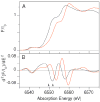Mn K-edge XANES and Kbeta XES studies of two Mn-oxo binuclear complexes: investigation of three different oxidation states relevant to the oxygen-evolving complex of photosystem II
- PMID: 11459481
- PMCID: PMC3959873
- DOI: 10.1021/ja004306h
Mn K-edge XANES and Kbeta XES studies of two Mn-oxo binuclear complexes: investigation of three different oxidation states relevant to the oxygen-evolving complex of photosystem II
Abstract
Two structurally homologous Mn compounds in different oxidation states were studied to investigate the relative influence of oxidation state and ligand environment on Mn K-edge X-ray absorption near-edge structure (XANES) and Mn Kbeta X-ray emission spectroscopy (Kbeta XES). The two manganese compounds are the di-mu-oxo compound [L'2Mn(III)O2Mn(IV)L'2](ClO4)3, where L' is 1,10-phenanthroline (Cooper, S. R.; Calvin, M. J. Am. Chem. Soc. 1977, 99, 6623-6630) and the linear mono-mu-oxo compound [LMn(III)OMn(III)L](ClO4)2, where L- is the monoanionic N,N-bis(2-pyridylmethyl)-N'-salicylidene-1,2-diaminoethane ligand (Horner, O.; Anxolabéhère-Mallart, E.; Charlot, M. F.; Tchertanov, L.; Guilhem, J.; Mattioli, T. A.; Boussac, A.; Girerd, J.-J. Inorg. Chem. 1999, 38, 1222-1232). Preparative bulk electrolysis in acetonitrile was used to obtain higher oxidation states of the compounds: the Mn(IV)Mn(IV) species for the di-mu-oxo compound and the Mn(III)Mn(IV) and Mn(IV)Mn(IV) species for the mono-mu-oxo compound. IR, UV/vis, EPR, and EXAFS spectra were used to determine the purity and integrity of the various sample solutions. The Mn K-edge XANES spectra shift to higher energy upon oxidation when the ligand environment remains similar. However, shifts in energy are also observed when only the ligand environment is altered. This is achieved by comparing the di-mu-oxo and linear mono-mu-oxo Mn-Mn moieties in equivalent oxidation states, which represent major structural changes. The magnitude of an energy shift due to major changes in ligand environment can be as large as that of an oxidation-state change. Therefore, care must be exercised when correlating the Mn K-edge energies to manganese oxidation states without taking into account the nature of the ligand environment and the overall structure of the compound. In contrast to Mn K-edge XANES, Kbeta XES spectra show less dependence on ligand environment. The Kbeta1,3 peak energies are comparable for the di-mu-oxo and mono-mu-oxo compounds in equivalent oxidation states. The energy shifts observed due to oxidation are also similar for the two different compounds. The study of the different behavior of the XANES pre-edge and main-edge features in conjunction with Kbeta XES provides significant information about the oxidation state and character of the ligand environment of manganese atoms.
Figures









Similar articles
-
Experimental and computational X-ray emission spectroscopy as a direct probe of protonation states in oxo-bridged Mn(IV) dimers relevant to redox-active metalloproteins.Inorg Chem. 2013 Nov 18;52(22):12915-22. doi: 10.1021/ic400821g. Epub 2013 Oct 25. Inorg Chem. 2013. PMID: 24161081 Free PMC article.
-
FTIR spectra and normal-mode analysis of a tetranuclear manganese adamantane-like complex in two electrochemically prepared oxidation states: relevance to the oxygen-evolving complex of photosystem II.J Am Chem Soc. 2002 Sep 18;124(37):11008-17. doi: 10.1021/ja020409j. J Am Chem Soc. 2002. PMID: 12224948 Free PMC article.
-
Characterization of the manganese O2-evolving complex and the iron-quinone acceptor complex in photosystem II from a thermophilic cyanobacterium by electron paramagnetic resonance and X-ray absorption spectroscopy.Biochemistry. 1988 May 31;27(11):4021-31. doi: 10.1021/bi00411a019. Biochemistry. 1988. PMID: 2843222
-
Manganese-Oxygen Intermediates in O-O Bond Activation and Hydrogen-Atom Transfer Reactions.Acc Chem Res. 2017 Nov 21;50(11):2706-2717. doi: 10.1021/acs.accounts.7b00343. Epub 2017 Oct 24. Acc Chem Res. 2017. PMID: 29064667 Review.
-
X-ray spectroscopy-based structure of the Mn cluster and mechanism of photosynthetic oxygen evolution.Biochim Biophys Acta. 2001 Jan 5;1503(1-2):7-23. doi: 10.1016/s0005-2728(00)00217-6. Biochim Biophys Acta. 2001. PMID: 11115621 Free PMC article. Review.
Cited by
-
Photon-in photon-out hard X-ray spectroscopy at the Linac Coherent Light Source.J Synchrotron Radiat. 2015 May;22(3):612-20. doi: 10.1107/S1600577515004488. Epub 2015 Apr 15. J Synchrotron Radiat. 2015. PMID: 25931076 Free PMC article.
-
Reaction landscape of a pentadentate N5-ligated Mn(II) complex with O2˙- and H2O2 includes conversion of a peroxomanganese(III) adduct to a bis(μ-oxo)dimanganese(III,IV) species.Dalton Trans. 2013 Sep 28;42(36):13014-25. doi: 10.1039/c3dt51277k. Epub 2013 Jul 19. Dalton Trans. 2013. PMID: 23872704 Free PMC article.
-
Chloride ligation in inorganic manganese model compounds relevant to photosystem II studied using X-ray absorption spectroscopy.J Biol Inorg Chem. 2004 Apr;9(3):247-55. doi: 10.1007/s00775-003-0520-1. Epub 2004 Feb 3. J Biol Inorg Chem. 2004. PMID: 14758524 Free PMC article.
-
Observation of Seeded Mn Kβ Stimulated X-Ray Emission Using Two-Color X-Ray Free-Electron Laser Pulses.Phys Rev Lett. 2020 Jul 17;125(3):037404. doi: 10.1103/PhysRevLett.125.037404. Phys Rev Lett. 2020. PMID: 32745427 Free PMC article.
-
Two-dimensional Kβ-Kα fluorescence spectrum by nonlinear resonant inelastic X-ray scattering.Nat Commun. 2023 Jul 17;14(1):4262. doi: 10.1038/s41467-023-39967-4. Nat Commun. 2023. PMID: 37460582 Free PMC article.
References
-
- Cooper SR, Calvin M. J Am Chem Soc. 1977;99:6623–6630.
-
- Horner O, Anxolabéhère-Mallart E, Charlot MF, Tchertanov L, Guilhem J, Mattioli TA, Boussac A, Girerd J-J. Inorg Chem. 1999;38:1222–1232. - PubMed
-
- Kirby JA, Goodin DB, Wydrzynski T, Robertson AS, Klein MP. J Am Chem Soc. 1981;103:5537–5542.
-
- Yachandra VK, Sauer K, Klein MP. Chem Rev. 1996;96:2927–2950. - PubMed
Publication types
MeSH terms
Substances
Grants and funding
LinkOut - more resources
Full Text Sources
Research Materials
Miscellaneous

